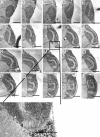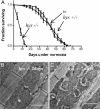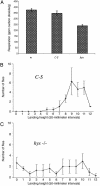Mitochondrial "swirls" induced by oxygen stress and in the Drosophila mutant hyperswirl
- PMID: 15229323
- PMCID: PMC478565
- DOI: 10.1073/pnas.0403767101
Mitochondrial "swirls" induced by oxygen stress and in the Drosophila mutant hyperswirl
Abstract
Mitochondrial dysfunction and reactive oxygen species have been implicated in the aging process as well as a wide range of hereditary and age-related diseases. Identifying primary events that result from acute oxidative stress may provide targets for therapeutic interventions that preclude aging. By using electron microscopy, we have discovered a striking initial pattern of degeneration of the mitochondria in Drosophila flight muscle under hyperoxia (100% O2). Within individual mitochondria, the cristae become locally rearranged in a pattern that we have termed a "swirl." Serial sections through individual mitochondria reveal the reorganization of the cristae in three dimensions. The cristae involved in a swirl are deficient in respiratory enzyme cytochrome c oxidase activity, within an otherwise cytochrome c oxidase-positive mitochondrion. In addition, under hyperoxia cytochrome c undergoes a conformational change, manifested by display of an otherwise hidden epitope. The conformational change is correlated with widespread apoptotic cell death in the flight muscle, as revealed by in situ terminal deoxynucleotidyltransferase-mediated dUTP nick end labeling. In normal flies, mitochondrial swirls accumulate slowly with age. To investigate the molecular mechanisms involved in oxygen toxicity, we conducted a genetic screen for mutants that display altered survival under hyperoxia, and we identified both sensitive and resistant mutants. We describe a mutant, hyperswirl, which displays an overabundance of swirls with associated respiratory and flight defects and a greatly reduced lifespan. Such mutants can identify genes that are needed to maintain mitochondrial homeostasis throughout the lifespan.
Figures








Similar articles
-
Hypersensitivity to oxygen and shortened lifespan in a Drosophila mitochondrial complex II mutant.Proc Natl Acad Sci U S A. 2006 Oct 31;103(44):16382-7. doi: 10.1073/pnas.0607918103. Epub 2006 Oct 20. Proc Natl Acad Sci U S A. 2006. PMID: 17056719 Free PMC article.
-
Loss of the Drosophila m-AAA mitochondrial protease paraplegin results in mitochondrial dysfunction, shortened lifespan, and neuronal and muscular degeneration.Cell Death Dis. 2018 Feb 21;9(3):304. doi: 10.1038/s41419-018-0365-8. Cell Death Dis. 2018. PMID: 29467464 Free PMC article.
-
Loss of BOSS Causes Shortened Lifespan with Mitochondrial Dysfunction in Drosophila.PLoS One. 2017 Jan 3;12(1):e0169073. doi: 10.1371/journal.pone.0169073. eCollection 2017. PLoS One. 2017. PMID: 28045997 Free PMC article.
-
Mitochondria in organismal aging and degeneration.Biochim Biophys Acta. 1999 Feb 9;1410(2):183-93. doi: 10.1016/s0005-2728(98)00166-2. Biochim Biophys Acta. 1999. PMID: 10076026 Review.
-
The role of mitochondrial oxidative stress in aging.Free Radic Biol Med. 2003 Jul 1;35(1):1-8. doi: 10.1016/s0891-5849(03)00184-9. Free Radic Biol Med. 2003. PMID: 12826250 Review.
Cited by
-
Caterpillars selected for large body size and short development time are more susceptible to oxygen-related stress.Ecol Evol. 2013 May;3(5):1305-16. doi: 10.1002/ece3.551. Epub 2013 Apr 8. Ecol Evol. 2013. PMID: 23762517 Free PMC article.
-
Consequences of Folding the Mitochondrial Inner Membrane.Front Physiol. 2020 Jun 9;11:536. doi: 10.3389/fphys.2020.00536. eCollection 2020. Front Physiol. 2020. PMID: 32581834 Free PMC article. Review.
-
Organelle aging: Lessons from model organisms.J Genet Genomics. 2019 Apr 20;46(4):171-185. doi: 10.1016/j.jgg.2019.03.011. Epub 2019 Apr 25. J Genet Genomics. 2019. PMID: 31080045 Free PMC article. Review.
-
Heat shock proteins and Drosophila aging.Exp Gerontol. 2011 May;46(5):355-62. doi: 10.1016/j.exger.2010.09.002. Epub 2010 Sep 16. Exp Gerontol. 2011. PMID: 20840862 Free PMC article. Review.
-
Modeling pathogenic mutations of human twinkle in Drosophila suggests an apoptosis role in response to mitochondrial defects.PLoS One. 2012;7(8):e43954. doi: 10.1371/journal.pone.0043954. Epub 2012 Aug 28. PLoS One. 2012. PMID: 22952820 Free PMC article.
References
-
- Harman, D. (1957) J. Gerontol. 2, 298–300. - PubMed
-
- de Grey, A. D. (1999) The Mitochondrial Free Radical Theory of Aging (RG Landes, Austin, TX).
-
- Finkel, T. & Holbrook, N. J. (2000) Nature 408, 239–247. - PubMed
-
- Marnett, L. J., Hurd, H. K., Hollstein, M. C., Levin, D. E., Esterbauer, H. & Ames, B. N. (1985) Mutat. Res. 148, 25–34. - PubMed
Publication types
MeSH terms
Substances
Grants and funding
LinkOut - more resources
Full Text Sources
Medical
Molecular Biology Databases

